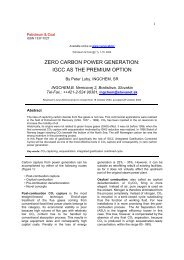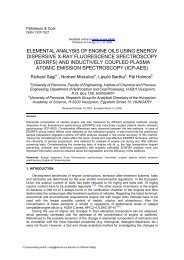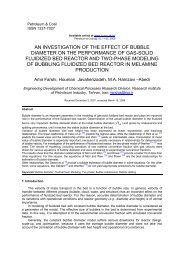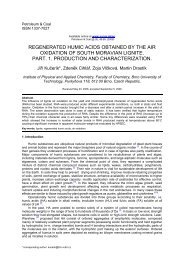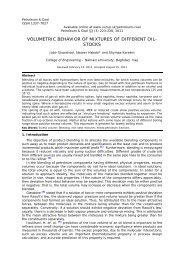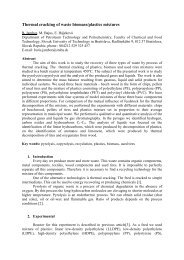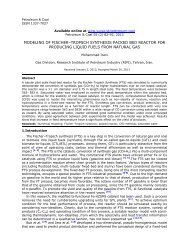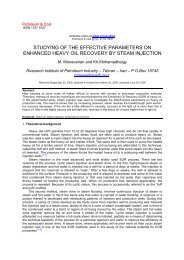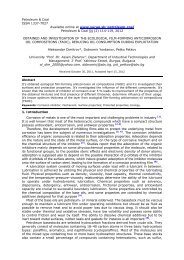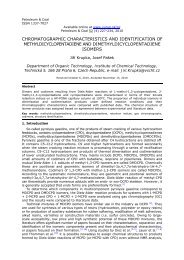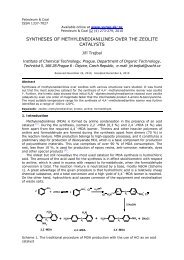THE INFLUENCE OF MECHANICAL EFFECTS ON DEGRADATION ...
THE INFLUENCE OF MECHANICAL EFFECTS ON DEGRADATION ...
THE INFLUENCE OF MECHANICAL EFFECTS ON DEGRADATION ...
You also want an ePaper? Increase the reach of your titles
YUMPU automatically turns print PDFs into web optimized ePapers that Google loves.
J. Shanshool et al./Petroleum & Coal 53(3) 218-222, 2011 221<br />
The effect of concentration of polymer solutions on the scission of polymer chains by<br />
high speed stirring had been investigated by change the viscosities, as shown in figures 4<br />
for Oppanol B 250. Three polymer concentrations were chosen, namely 0.5%, 1.0%<br />
and 1.4%w/v to evaluate the concentration dependence of shear degradation of the<br />
three Oppanol polymers by expose there solutions to high speed stirring. It was found<br />
that the low concentration solutions are less sensitive to shear degradation by<br />
mechanical stirring. The polymer chain scission is largely dependent on the<br />
concentration of polymer solution that lead to the conclusion that the polymer chains<br />
were not broken by contact only with solvent but even though by contact of a polymer<br />
chain (entanglement) with other chains [9] .<br />
As illustrated adequately in the previous paragraph, the viscosity of Oppanol B polymers<br />
undergo remarkable reduction by exposure there solutions to high speed mechanical stirring.<br />
Therefore it was worthy to compare the results of shear degradation by stirring of the<br />
three Oppanol polymers solution with the values of time dependence drag–reduction<br />
efficiency. Since the long chain polymers experience mid–point degradation, leading to<br />
the fact that the molecular chains having different molecular weights will show different<br />
time dependent resistance. The time dependence drag–reduction results for these polymers<br />
are shown in figure 5 which were carried at 6.0m 3 /hr flow rate in 31.75mm I.D pipe. The<br />
figure indicates that, the low molecular weight polymers are sharply degraded within the<br />
first hour resulting in fast decrease of percentage drag–reduction. While the higher<br />
molecular weight polymer has higher resistance towards the degradation. Therefore in case<br />
of Oppanol B 250 additive, still about 9% drag reduction was achieved after 210min operation<br />
due to presence of efficient molecules, which act as drag reducer agents. The effectiveness<br />
of low molecular weight polymer B 150 was completely vanished after about one<br />
hour circulation leading to minor drag reduction , while B 200 shows little drag–reduction<br />
effectiveness after 150min circulation. It was observed previously that exposure of<br />
Oppanol B, 150, 200 and 250 polymeric solutions to high speed stirring, (1800rpm)<br />
leading to noticeable decrease in viscosity due to mechanical degradation.<br />
The time-dependence drag reduction of Oppanol B 250 at different concentrations is<br />
plotted in figure 6 taking the time zero for maximum drag reduction. This figure indicates<br />
clearly that low concentrations will be degraded quickly compared with high concentration<br />
i.e 50ppm. Therefore the percentage DR decrease rapidly reaching to zero value after<br />
60min for 10ppm and 120min running for 30ppm. While at 50ppm concentration there is<br />
still undegraded polymer until 220 min experimental time elapsed. Since degradation is<br />
generally attributed to mechanical breaking of the polymer chains and when a low concentration<br />
exists in the pipe a larger performance of chains are destroyed and consequently a<br />
rapid decrease in the effective drag reduction is noticed. While, for high concentrations<br />
i.e 50ppm there is still sufficient effective polymer left to cause drag reduction at the<br />
considered experimental time.<br />
24<br />
20<br />
Oppanol B 150<br />
Oppanol B 200<br />
Oppanol B 250<br />
24<br />
20<br />
10 ppm<br />
30 ppm<br />
50 ppm<br />
16<br />
16<br />
DR%<br />
12<br />
8<br />
DR%<br />
12<br />
8<br />
4<br />
4<br />
0<br />
0 30 60 90 120 150 180 210 240<br />
Time (min)<br />
Fig. 5 Effect of molecular weight on degradation<br />
of Oppanol B additives, at Q= 6<br />
m 3 /hr, 50 ppm concentration and 31.75<br />
mm I.D<br />
0<br />
0 30 60 90 120 150 180 210 240<br />
Time (min)<br />
Fig. 6Time dependence of percentage<br />
drag-reduction for Oppanol B 250 at<br />
different concentration, 6 m 3 /hr flow rate<br />
and 31.75 mm I.D



